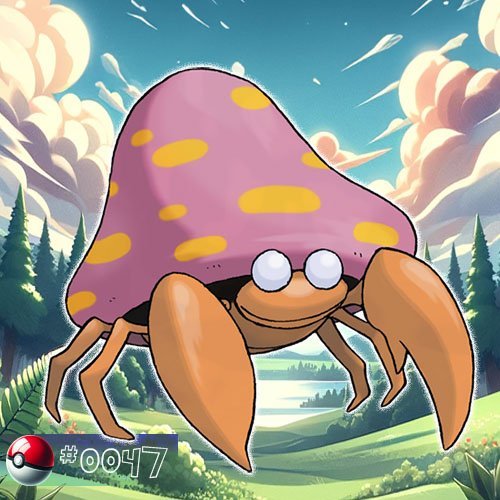Parasect
Parasect is a Bug/Grass-type Pokémon known for its parasitic mushroom, which takes over its host’s body upon evolution.
Biology
Physical Characteristics
Parasect is a Pokémon with distinct physical characteristics.
Parasect is of medium size, with a slightly hunched posture. Its body is relatively broad, providing a stable base for its multiple legs.
Parasect’s exoskeleton is durable and serves as protective armor. It covers most of its body, providing a sturdy defense against external threats. The parasitic mushroom on Parasect’s back is a crucial aspect. It has a cap, stalk, and gills. The gills release spores that have various effects on opponents and the environment.
The takeover of Parasect by the mushroom is a unique aspect. While the mushroom controls its actions, there is a symbiotic relationship between Paras and the fungus, suggesting a shared existence.
Parasect has two short antennae emerging from its forehead. These sensory organs contribute to its perception of the surrounding environment. It typically has large, round eyes, often appearing blank or devoid of distinct pupils. Parasect boasts six jointed legs, three on each side. The legs are adapted for both stability and mobility.
The exoskeleton is predominantly beige, while the mushroom can vary in color, often featuring shades of red or orange.
These intricate details collectively contribute to the intriguing and unique appearance of Parasect in the Pokémon world.
Behaviour
Parasect exhibits interesting behaviors that are influenced by its parasitic mushroom. Here are detailed aspects of Parasect’s behavior.
The most notable behavior of Parasect is the influence of the parasitic mushroom on its back. The fungus takes control of Parasect, directing its actions. This symbiotic relationship, while providing enhanced power, also raises questions about the autonomy of Parasect.
Parasect’s mushroom is known to release spores. These spores have diverse effects, ranging from inducing sleep to causing paralysis. The release of spores is a defensive mechanism that aids Parasect in battle.
Despite the apparent control exerted by the mushroom, there is a level of cooperation between Paras and the fungus. This unique symbiosis suggests a shared existence where both entities benefit from each other.
In the wild, Parasect may exhibit protective instincts, especially when it comes to safeguarding its mushroom. Threats to the mushroom are likely to trigger defensive reactions from Parasect. Like its pre-evolution Paras, Parasect is likely to engage in foraging behavior. It may use its sharp claws to dig into the ground in search of nutrients, showcasing typical insect-like behaviors.
In the Pokémon world, Parasect may be found in groups or colonies. The dynamics within these groups could involve cooperative actions, especially in defending their habitats or foraging grounds. Given its mushroom’s reliance on moonlight for spore release, Parasect might exhibit nocturnal behaviors. It could be more active during the night, aligning with the natural cycles of its parasitic companion.
Parasect, with its antennae and multiple eyes, likely demonstrates a heightened sense of awareness. It could be alert to changes in its environment, aiding in both defensive responses and seeking out potential hosts.
These behavioral traits contribute to the unique and intriguing nature of Parasect in the Pokémon world, shaped by the symbiotic relationship with its parasitic mushroom.
Evolution
Paras evolves into Parasect, and this evolutionary process involves distinct stages. Here’s a detailed overview of Parasect’s evolution.
Paras is the initial stage of this evolutionary line. Found in damp, forested areas, Paras resembles a small insect with a mushroom on its back. It exhibits behaviors typical of an insect, including foraging for nutrients and living in groups. As Paras grows, a parasitic mushroom on its back also develops. This fungus eventually takes control of Paras, influencing its behavior and leading to the next stage of evolution.
The evolution from Paras to Parasect (at level 24) is triggered by the maturation of the parasitic mushroom. This process alters Paras both physically and behaviorally. The mushroom gains dominance, directing Parasect’s actions while providing enhanced power.
Upon evolving, Parasect undergoes noticeable physical transformations. Its size increases, and the parasitic mushroom on its back becomes larger and more prominent. The insectoid features become more defined, and it gains additional claws.
Parasect’s evolution grants it increased strength and capabilities. The mushroom now has a central role in controlling the Pokémon, and Parasect gains access to powerful moves and spore-based attacks. Despite the apparent control exerted by the mushroom, there are ongoing questions about the autonomy of Parasect. The exact nature of the relationship between Paras and its parasitic companion is a subject of intrigue in the Pokémon world.
Like many Pokémon, Paras evolves through experience gained in battles and training. As it reaches a certain level of maturity (level 24 usually), the transformation into Parasect occurs. The evolution may also be influenced by environmental factors, such as exposure to moonlight or specific locations. The presence of the parasitic mushroom could be linked to these conditions.
A strong bond with a Pokémon Trainer can sometimes influence the evolution process. Positive experiences and battles may contribute to Paras evolving into Parasect under the Trainer’s guidance.
Parasect’s evolution is marked by a unique symbiosis with the parasitic mushroom, showcasing the intricate relationships that exist within the Pokémon world.
Appearances
Anime Main Appearances
In the episode “The Problem with Paras”, Cassandra, one of the owners of a medicine shop in Mossgreen Village, possesses a frail Paras, crucial for evolving into Parasect to utilize its large mushroom for medical research. After the battles with most of Pokémon owned by Ash and Team Rocket, Paras’s evolution into Parasect occurs.
In the episode “Hocus Pokémon”, Lily, a magician, required Stun Spore from a Parasect to finalize a spell. Later, in “Gulpin it Down” Officer Jenny deployed a Parasect alongside her Meganium and Tangela to quell a rioting army of Gulpin. Additionally, Goh captured a Parasect in “Working My Way Back to Mew!” and it continued to play a role in subsequent episodes of Pokémon Journeys: The Series.
Anime Minor Appearances
Parasect’s diverse roles showcase its presence in the Pokémon world.
Parasect featured in various episodes, from receiving care in “A Chansey Operation” to competing in the Princess Festival (”Princess vs. Princess”). It appeared at the Pokémon Theme Park (”Pikachu’s Vacation”), sensed disturbances in “The Power of One” and joined in the adventure during “Pikachu’s Rescue Adventure”. Other appearances include living at Wings Alexander’s barn (”Throwing in the Noctowl”), residing at Professor Oak‘s Laboratory (”Showdown at the Oak Corral”), and playing in Lillie’s garden (“Lillie’s Egg-xhilarating Challenge!”).
Multiple Parasect appeared in the following episodes:
- ”Showdown at the Po-ké Corral” (seen living at the laboratory of Professor Oak)
- ”Celebi: The Voice of the Forest”
- ”For Ho-Oh the Bells Toll!” (protecting the Tin Tower after Team Rocket’s robbery)
- ”Destiny Deoxys”
A Coordinator’s Paras appeares in the episodes ”Harley Rides Again” and ”Once More With Reeling!” (participated in the Terracotta Contest).
A Trainer’s Parasect appeares also in the following epsodes:
- “Friends to the End” (Indigo Plateau Conference – at the closing ceremonies)
- “Alola to New Adventure!”
- “First Catch in Alola, Ketchum-Style! “
- “I Choose You! ”
- “Securing the Future!” (two of three Parasect in this episode were owned by different Trainers)
- “The Power of Us ” (four of six Parasect in this episode were owned by different Trainers)
- ”League Offenders and Defenders!”
- ”Battle Royal 151!” (Manalo Conference – competed in the preliminary round)
- ”Trade, Borrow, and Steal!” (one of two Parasect in this episode was owned by a Trainer)
- ”Take My Thief! Please!”
- ”Ultra Exciting from the Shocking Start!”
Manga Appearances
Pokémon Adventures
Parasect made its debut in “Long Live the Nidoking!” as one of the Pokémon featured in Fuchsia City’s Safari Zone.
Crystal’s Parasect, nicknamed Parasee, debuted in “Slugging It Out With Slugma.” Crystal utilizes it for Pokémon catching, employing Spore to induce sleep. With a Spore attack radius extending up to 3 kilometers, Parasect’s abilities prove crucial. In “Lively Larvitar,” its origin unfolds as a wild Pokémon in Mt. Mortar, aiding a berserk Arcanine and Crystal’s recovery from injuries. “Lugia and Ho-Oh on the Loose, Part 1” unveils another skill—Parasect combines powder attacks to create diverse spores, including those for corroding metals.
In “The Last Battle XIII”, a Parasect joined the fight in Ilex Forest. Additionally, an Aether Foundation Employee’s Parasect debuted in the episode “Play the Melody That Echoes in the Altar”.
Pokémon Gotta Catch ‘Em All
A Paras was seen in GDZ20 owned by Ran, the younger twins, and it reappeared later in GDZ44.
Pokémon Journeys: The Series
In the episode ”Battle Frontier Challenge: The Flute Cup!” a Parasect was captured by Goh.
Pokémon Pocket Monsters
In the episode ”The Big Battle In The Viridian Forest!!”, a Parasect owned by Green mad its first appearence.
Pokémon Ranger the Comic: Double Mission
In the episode ” Pokémon Ranger the Comic: Double Mission Episode Three”, Tiffany’s (the member of Go-Rock Squad) Parascet appears.
Game data
Stats
Location
| Game version | Location |
|---|---|
| Pokémon Red and Pokémon Blue | Cerulean Cave, Safari Zone |
| Pokémon Yellow | Route 18, Cerulean Cave, Safari Zone |
| Pokémon Gold and Pokémon Silver | Evolve Paras |
| Pokémon Crystal | Mt. Silver Cave |
| Pokémon Ruby and Pokémon Sapphire | Trade |
| Pokémon FireRed and Pokémon LeafGreen | Cerulean Cave, Safari Zone |
| Pokémon Emerald | Trade |
| Pokémon Colosseum | Trade |
| Pokémon XD | Evolve Paras |
| Pokémon Diamond and Pokémon Pearl | Evolve Paras |
| Pokémon Platinum | Evolve Paras |
| Pokémon HeartGold and Pokémon SoulSilver | Cerulean Cave, Safari Zone |
| Pokémon Black | Trade |
| Pokémon White | Evolve Paras |
| Pokémon Black 2 and Pokémon White 2 | Trade |
| Pokémon X and Pokémon Y | Evolve Paras |
| Pokémon Omega Ruby and Pokémon Alpha Sapphire | Evolve Paras |
| Pokémon Sun and Pokémon Moon | Evolve Paras |
| Pokémon Ultra Sun and Pokémon Ultra Moon | Route 11 |
| Pokémon: Let's Go, Pikachu! And Pokémon: Let's Go, Eevee! | Evolve Paras |
| Pokémon Sword and Pokémon Shield | Unobtainable |
| Pokémon Brilliant Diamond and Pokémon Shining Pearl | Evolve Paras |
| Legends Arceus | Nature’s Pantry, Cloudpool Ridge, Cottonsedge Prairie, Diamond Heath, Golden Lowlands, Heavenward Lookout, Wayward Wood, Windbreak Stand |
| Pokémon Scarlet and Pokémon Violet | Unobtainable |
Parasect's origin name
Parasect’s name is consistent across various languages.
English: The English name “Parasect” is a combination of “parasite” and “insect,” reflecting its parasitic and insect-like nature.
Japanese: In Japanese, Parasect is written as パラセクト (Parasecto), a phonetic transcription of its English name.
French: The French name for Parasect is also “Parasect,” maintaining consistency with the English name.
German: Similar to French, the German name for Parasect is “Parasect.”
Spanish: In Spanish, Parasect is also called “Parasect,” following the pattern of the English name.
Italian: The Italian name for Parasect is, once again, “Parasect,” aligning with the English nomenclature.
Korean: The Korean name is 파라섹트 (Parasegteu), transliterating the sounds of the English name into the Korean script.
Chinese (Simplified and Traditional): Both in Simplified and Traditional Chinese, Parasect is referred to as 派拉斯特 (Pàilāsītè).




